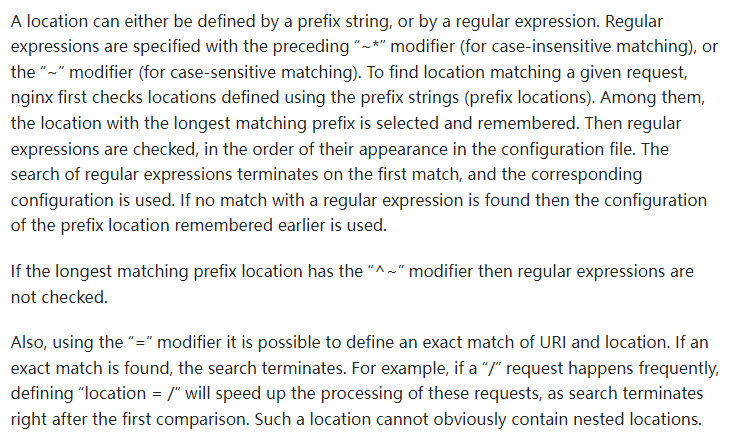前言
Location 是 Nginx 中一个非常核心的配置,这篇重点讲解一下 Location 的配置问题以及一些注意事项。
语法
关于 Location,举个简单的配置例子:
http {
server {
listen 80;
server_name www.yayujs.com;
location / {
root /home/www/ts/;
index index.html;
}
}
}
大致的意思是,当你访问 www.yayujs.com 的 80 端口的时候,返回 /home/www/ts/index.html 文件。
我们看下 Location 的具体语法:
location [ = | ~ | ~* | ^~ ] uri { ... }
重点看方括号中的 [ = | ~ | ~* | ^~ ],其中 | 分隔的内容表示你可能会用到的语法,其中:
- = 表示精确匹配,比如:
location = /test {
return 200 "hello";
}
# /test ok
# /test/ not ok
# /test2 not ok
# /test/2 not ok
* ~ 表示区分大小写的正则匹配,比如:
```bash
location ~ ^/test$ {
[ configuration ]
}
# /test ok
# /Test not ok
# /test/ not ok
# /test2 not ok
- ~* 表示不区分大小写的正则匹配
location ~* ^/test$ {
[ configuration ]
}
# /test ok
# /Test ok
# /test/ not ok
# /test2 not ok
- ^~ 表示 uri 以某个字符串开头
location ^~ /images/ {
[ configuration ]
}
# /images/1.gif ok
而当你不使用这些语法的时候,只写 uri 的时候:
/ 表示通用匹配:
location / {
[ configuration ]
}
# /index.html ok
location /test {
[ configuration ]
}
# /test ok
# /test2 ok
# /test/ ok
匹配顺序
当存在多个 location 的时候,他们的匹配顺序引用 Nginx 官方文档就是:

翻译整理后就是:
location 的定义分为两种:
- 前缀字符串(prefix string)
- 正则表达式(regular expression),具体为前面带 ~* 和 ~ 修饰符的
而匹配 location 的顺序为:
- 检查使用前缀字符串的 locations,在使用前缀字符串的 locations 中选择最长匹配的,并将结果进行储存
- 如果符合带有 = 修饰符的 URI,则立刻停止匹配
- 如果符合带有 ^~ 修饰符的 URI,则也立刻停止匹配。
- 然后按照定义文件的顺序,检查正则表达式,匹配到就停止
- 当正则表达式匹配不到的时候,使用之前储存的前缀字符串
再总结一下就是:
在顺序上,前缀字符串顺序不重要,按照匹配长度来确定,正则表达式则按照定义顺序。
在优先级上,= 修饰符最高,^~ 次之,再者是正则,最后是前缀字符串匹配。
我们举几个简单的例子复习下:
server {
location /doc {
[ configuration A ]
}
location /docu {
[ configuration B ]
}
}
# 请求 /document 使用 configuration B
# 虽然 /doc 也能匹配到,但在顺序上,前缀字符串顺序不重要,按照匹配长度来确定
server {
location ~ ^/doc {
[ configuration A ]
}
location ~ ^/docu {
[ configuration B ]
}
}
# 请求 /document 使用 configuration A
# 虽然 ~ ^/docu 也能匹配到,但正则表达式则按照定义顺序
server {
location ^~ /doc {
[ configuration A ]
}
location ~ ^/docu {
[ configuration B ]
}
}
# 请求 /document 使用 configuration A
# 虽然 ~ ^/docu 也能匹配到,但 ^~ 的优先级更高
server {
location /document {
[ configuration A ]
}
location ~ ^/docu {
[ configuration B ]
}
}
# 请求 /document 使用 configuration B
# 虽然 /document 也能匹配到,但正则的优先级更高
root 与 alias 的区别
当我们这样设置 root 的时候:
location /i/ {
root /data/w3;
}
当请求 /i/top.gif ,/data/w3/i/top.gif 会被返回。
当我们这样设置 alias 的时候:
location /i/ {
alias /data/w3/images/;
}
当请求 /i/top.gif ,/data/w3/images/top.gif 会被返回。
乍一看两者很像,但细一看,就能看出两者的区别,root 是直接拼接 root + location 而 alias 是用 alias 替换 location,所以 root 中最后的路径里有 /i/,而 alias 中最后的路径里没有 /i/ 。
所以如果你这样使用 allias 定义一个路径:
location /images/ {
alias /data/w3/images/;
}
其实使用 root 会更好:
location /images/ {
root /data/w3;
}
server 和 location 中的 root
server 和 location 中都可以使用 root,举个例子:
http {
server {
listen 80;
server_name www.yayujs.com;
root /home/www/website/;
location / {
root /home/www/ts/;
index index.html;
}
}
}
如果两者都出现,是怎样的优先级呢?
简单的来说,就是就近原则,如果 location 中能匹配到,就是用 location 中的 root 配置,忽略 server 中的 root,当 location 中匹配不到的时候,则使用 server 中的 root 配置。
作者:冴羽
(版权归原作者所有,侵删)
本文链接:https://www.yunweipai.com/40863.html






网友评论comments